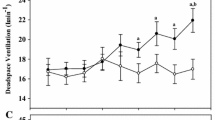Summary
The oxygen intakes of 16 well-trained Bantu mine recruits were studied while they pushed a mine car at a constant speed of 2 miles p. h. The car had dry or partially lubricated axles and was pushed with loads of 0, 1000, 1500 and 2000 lb added to the car. When the car was empty the degree of lubrication had only a small effect on the mean oxygen intake of members of the group. With an increase in the load the differences in oxygen intake became greater and were all significant. For a maximum load of 2000 lb the oxygen intake values were 2.36, 1.70 and 1.40 l/min respectively for badly lubricated, partially lubricated and well lubricated axles. The average Bantu mine recruit with a maximum oxygen intake capacity of 2.80 l/min is well suited for pushing mine cars which are loaded to capacity and well lubricated. To push a badly lubricated car, when it is loaded to capacity, requires a labourer with a maximum oxygen intake capacity of 4.72 l/min. Few individuals would qualify for the task. In the practical situation, where ambient air temperatures are high, labourers engaged in pushing mine cars are at a double disadvantage. Anaerobic metabolism, and therefore fatigue, begins at lower levels of oxygen intake in heat than in comfortable conditions. To maintain the body in thermal equilibrium with its environment is also more difficult. Lubrication of mine cars, in addition to reducing work loads, therefore gives significant protection against disturbance of the thermal equilibrium of the body under hot working conditions.
Similar content being viewed by others
References
Astrand, P. O.: Experimental studies of physical working capacity in relation to sex and age. Copenhagen: Munksgaard 1952.
Brouha, L.: Fatigue, measuring and reducing it. Advanced Management, January 1954.
- Protecting the worker in hot environments. 20th Ann. Meeting of Ind. Hyg. Foundation, November 1955.
Christensen, E. H.: In: Symposium on Fatigue p. 93. London: Ergonomics Research Soc. 1953.
Hill, A. V., andH. Lupton: Muscular exercise, lactic acid and the supply and utilization of oxygen. Quart. J. Med.16, 135–171 (1923).
Maritz, J. S., J. F. Morrison, J. Peter, N. B. Strydom andC. H. Wyndham: A practical method of estimating an individual's maximal oxygen intake. Ergonomics4, 97–122 (1961).
Williams, C. G., G. A. G. Bredell, C. H. Wyndham, N. B. Strydom, J. F. Morrison, P. W. Fleming andJ. S. Ward: Circulatory and metabolic reactions to work in heat. J. Appl. physiol.17, 625–638 (1962).
Wyndham, C. H., N. B. Strydom, J. F. Morrison, J. Peter, J. S. Maritz andJ. S. Ward: The influence of a stable diet and regular work on body weight and capacity for exercise of African mine recruits. Ergonomics5, 435–444 (1962).
— —,C. G. Williams, and M.von Rahden: A physiological basis for the optimum level of energy expenditure. Nature195, 1210–1212 (1962).
Author information
Authors and Affiliations
Rights and permissions
About this article
Cite this article
Williams, C.G., Viljoen, J.H., van Graan, C.H. et al. The influence of lubrication on the energy cost of pushing a mine car. Int. Z. Angew. Physiol. Einschl. Arbeitsphysiol. 22, 311–316 (1966). https://doi.org/10.1007/BF00698283
Received:
Issue Date:
DOI: https://doi.org/10.1007/BF00698283




